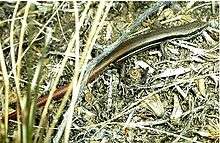Morethia boulengeri
Morethia boulengeri is a species of lizard in the family Scincidae. The species is endemic to Australia.
| Morethia boulengeri | |
|---|---|
 | |
| Scientific classification | |
| Kingdom: | Animalia |
| Phylum: | Chordata |
| Class: | Reptilia |
| Order: | Squamata |
| Family: | Scincidae |
| Genus: | Morethia |
| Species: | M. boulengeri |
| Binomial name | |
| Morethia boulengeri (Ogilby, 1890) | |
.png) | |
| Synonyms[2] | |
| |
Common names
Common names for Morethia boulengeri include south-eastern Morethia skink,[2] Boulenger's snake-eyed skink,[3] Boulenger's Morethia,[3] and Boulenger's skink.[4]
Etymology
The specific name, boulengeri, as well as three of the common names for this skink, are in honour of George Albert Boulenger,[3] a Belgian-born British herpetologist who described a wide range of reptile, amphibian, and fish species new to science.
Description
The markings and colouration of M. boulengeri can vary significantly between individuals. In general, it is grey or brown in colour with darker-coloured flecks in a longitudinal pattern along the dorsal side of the lizard, while the ventral side is largely white. A thin white stripe also runs longitudinally from the mouth to the groin region on both lateral sides. Above the white line is a thicker black stripe that borders the white stripes.[5] Juvenile lizards also have a distinctive red-orange tinge on the ventral side of the tail, which is a distinguishing feature of the genus Morethia. Boulenger's skink can grow to a total length (including tail) of10 cm (3.9 in); however, on average they reach only 8 cm (3.1 in) nose to tail tip, or 4.5–5 cm (1.8–2.0 in) snout to vent.[6] This species of skink also exhibits square-shaped supraciliary scales above the eye region.
Geographic range and ecology
M. boulengeri is endemic to Australia and can be found across the majority of the country, in every state and territory except Tasmania. It is a generalist species that has the ability to inhabit a wide range of environments in semi-arid and arid zones. It survives in the leaf litter and dead fallen vegetation in dry sclerophyll forests, mallee, desert, scrublands, woodlands, and low shrublands ecosystems.[5] It is found in high numbers in the Murray catchment area, in southern New South Wales. Sometimes the density of M. boulengeri is as high as several hundred individuals in one hectare of land.[7]
Diet
M. boulengeri is an insectivorous species, like the majority of skinks, which means the diet of this species consist almost exclusively of insects. It eats predominately arthropod species and snails, with moths making up a large portion of its diet.[8] Spiders, beetles, ants, cockroaches, and other bugs are also a part of the diet. All of these prey species are abundant within Australia and in the leaf litter habitat that M. boulengeri occupies.
Reproduction
M. boulengeri mates in the warmer months in spring and summer.[9] During this time the throat of the male skink turns vibrant orange in correspondence with testicle size, indicating to the female that the male is fertile and available for mating.[10] This species of skink is oviparous which is a method of reproduction in which the female lays eggs. A female M. boulengeri generally reaches sexual maturity and begins breeding within the first year of life. On average, 3 eggs are laid per clutch, and a female produces approximately 3 clutches per year.[11] The clutch is incubated for approximately 60 days before the eggs hatch. During this time the rate of oxygen consumption dramatically increases.[12]
References
| Wikimedia Commons has media related to Morethia boulengeri. |
| Wikispecies has information related to Morethia boulengeri |
- Hutchinson MN (2010). "Morethia boulengeri". IUCN Red List of Threatened Species. 2010. Retrieved 8 November 2014.CS1 maint: ref=harv (link)
- Morethia boulengeri at the Reptarium.cz Reptile Database. Accessed 8 November 2014.
- Beolens, Bo; Watkins, Michael; Grayson, Michael (2011). The Eponym Dictionary of Reptiles. Baltimore: Johns Hopkins University Press. xiii + 296 pp. ISBN 978-1-4214-0135-5. (Morethia boulengeri, p. 33).
- OzAnimals.com.
- Cogger H (2014). Reptiles and Amphibians of Australia. Collingwood: CSIRO Publishing. Seventh Edition. p:660-661.
- Rayner I (2007). "Morethia boulengeri ". "CSIRO Life in the Suburbs". Retrieved 2014-10-12.
- Michael D, Lindenmayer D (2010). Reptiles of the NSW Murray Catchment: A Guide to Their Identification, Ecology & Conservation. Collingwood: CSIRO Publishing. p:154. Reptiles of the NSW Murray Catchment: A Guide to Their Identification, Ecology & Conservation.. Retrieved 2014-10-15.
- Hoser R (1989). Australian Reptiles & Frogs. Mosman: Pierson & Co. p. 105.
- Smyth M (1974). "Changes in the fat scores of the skinks Morethia boulengeri and Hemiergis peronii (Lacertilia)". Australian J. Zool. 22 (2): 135-145."CSIRO Publishing - Australian Journal of Zoology". Retrieved 2008-12-23.
- Smyth M (1974). "Aspects of the Natural History of Three Australian Skinks, Morethia boulengeri, Menetia greyii and Lerista bougainvillii ". Journal of Herpetology 8 (4): 329-335. JSTOR 1562902
- Henle K (1989). "Population Ecology and Life History of the Diurnal Skink Morethia boulengeri in Arid Australia". Oecologia 78 (4): 521-532. . JSTOR 4218901
- Thompson M, Russell K (1999). "Embryonic Energetics in Eggs of Two Species of Australian Skink, Morethia boulengeri and Morethia adelaidensis ". Journal of Herpetology 33 (2): 291-297. JSTOR 1565726
Further reading
- Greer AE (1974). "The generic relationships of the scincid lizard genus Leiolopisma and its relatives". Australian Journal of Zoology Supplementary Series 22 (31): 1-67. (Morethia boulengeri, new combination, p. 21).
- Ogilby JD (1890). "Re-Description of an Ablepharus from Australia". Records of the Australian Museum 1:10-11. (Ablepharus boulengeri, new species).
External links
- "NLBIF : Morethia boulengeri OGILBY 1890". Archived from the original on 2011-07-18. Retrieved 2008-12-23.
- "Herpetology - Type Collection - Morethia boulengeri". Retrieved 2008-12-23.
- "Boulenger's Skink", OzAnimals.com.
- Morethia boulengeri, The Reptile Database.
